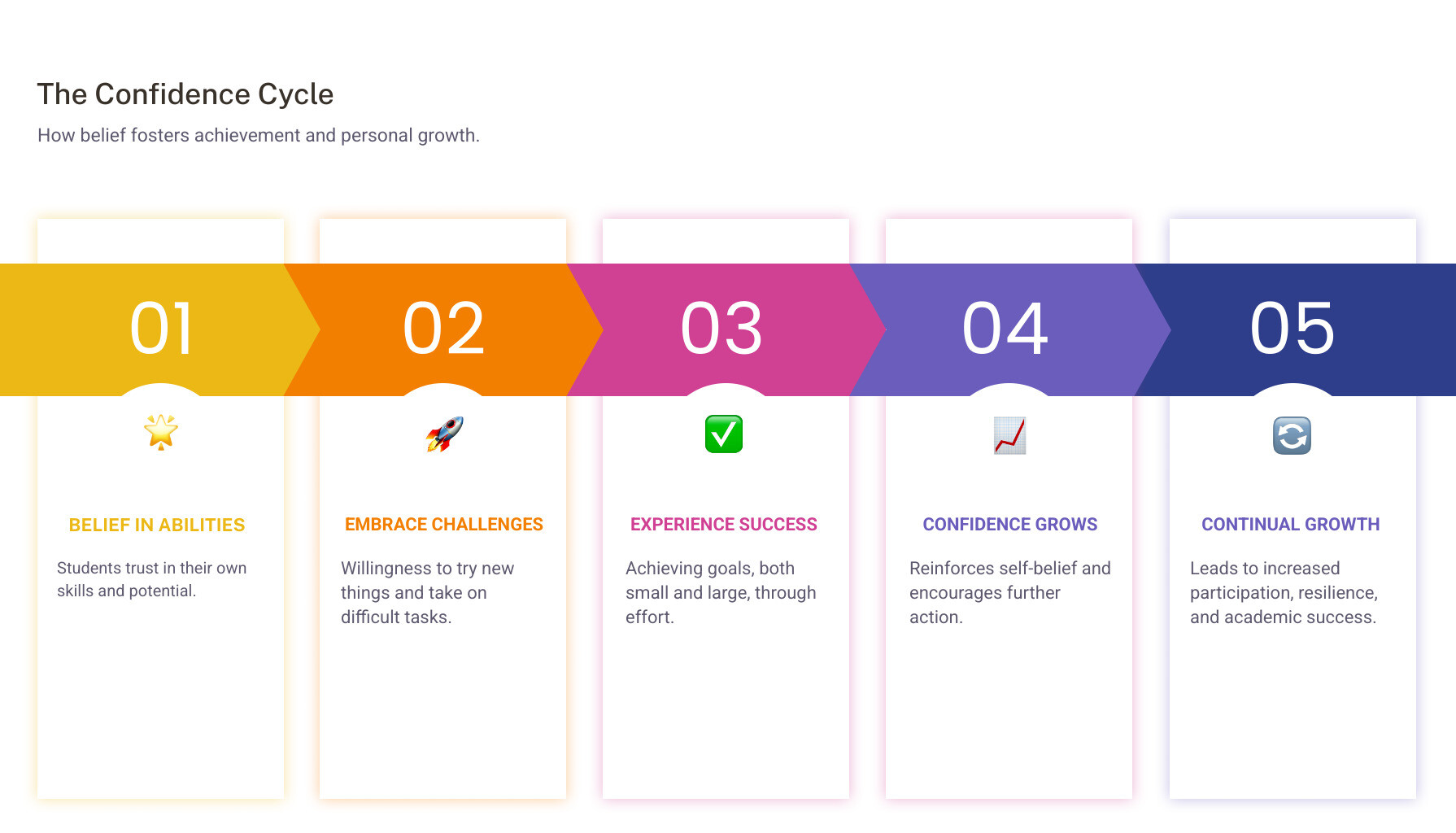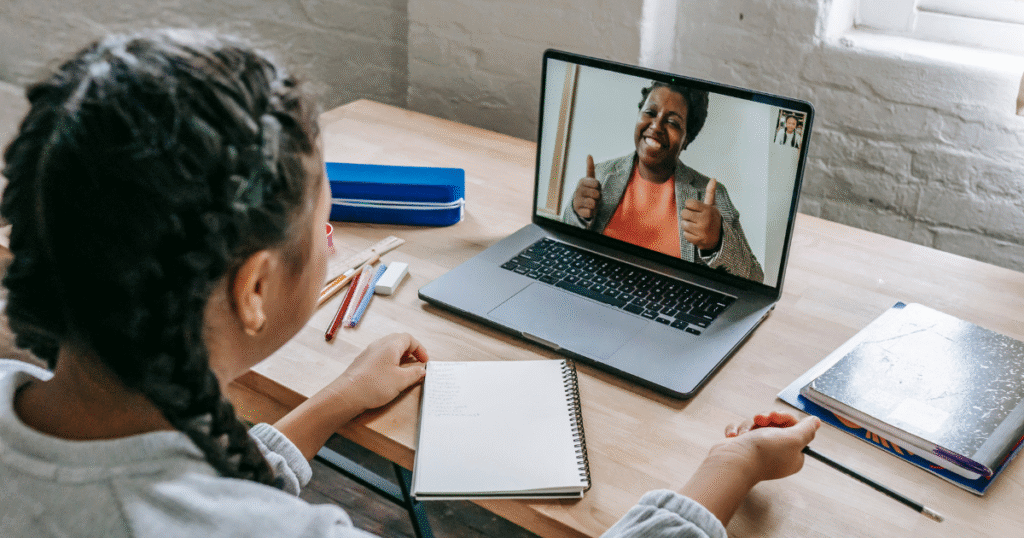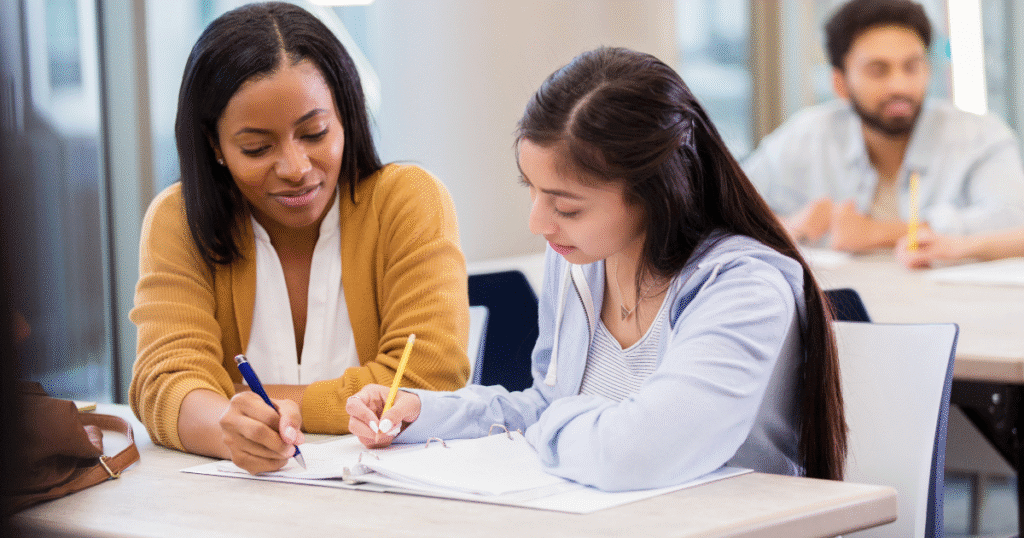
Why a Confident Student is a Successful Student
To build student confidence is to lay the foundation for a lifetime of academic success and personal growth. Confidence is not merely a feeling; it is the engine that drives a student’s willingness to engage, persevere, and ultimately, succeed. When students believe in their own capabilities, they are more likely to take on difficult challenges, view setbacks as temporary problems rather than impossible walls, and participate more actively in their own learning journey. This internal belief system acts as a buffer against the inevitable frustrations of education, changing potential moments of defeat into valuable learning opportunities.
Student confidence is a realistic and secure belief in one’s abilities, and it is directly correlated with the development of a growth mindset—the understanding that intelligence and skills can be developed through dedication and hard work. Research consistently shows that confident students are more likely to speak up in class, ask for help when they need it, and absorb new material more effectively. The critical difference between a student who gives up after a failed test and one who analyzes their mistakes and tries a new study strategy often comes down to this core belief in their ability to improve.
As a parent, you are the primary architect of your child’s initial self-concept as a learner. Your words, actions, and attitudes toward learning and challenges profoundly shape their inner voice. I’m Peter Panopoulos, and with over 12 years of experience helping students across Massachusetts build student confidence, first in the classroom and now through personalized one-on-one online tutoring, I have seen how the right support can transform a hesitant, struggling student into a self-assured, capable learner.
Foundational Strategies to Build Student Confidence:
- Praise Effort Over Innate Ability: Instead of saying “You’re so smart,” focus on the process: “I saw how you worked through that tough problem without giving up. Your persistence is amazing!” This teaches children that their success is within their control and a direct result of their hard work, not some fixed trait.
- Accept the Power of “Not Yet”: The simple act of reframing “I can’t do it” to “I can’t do it yet” is transformative. It replaces a statement of permanent failure with an acknowledgment of a temporary state, implying that future success is possible with continued effort and practice.
- Set Small, Achievable Goals: Large, daunting tasks can be overwhelming. Break them down into smaller, manageable steps. Completing each small step provides a sense of accomplishment and builds momentum, making the larger goal seem far less intimidating. This process creates a track record of success that serves as tangible proof of their capabilities.
- Create a Safe Space for Mistakes: Frame mistakes not as failures, but as essential parts of the learning process. When a child makes an error, avoid criticism and instead ask, “What did we learn from this?” or “What could we try differently next time?” This approach removes the fear associated with being wrong and encourages academic risk-taking.
- Assign Age-Appropriate Responsibilities: Giving children ownership over tasks—like packing their own school bag, managing their homework schedule, or helping with household chores—builds a sense of competence and trust. It sends the message that you believe they are capable and responsible.
- Provide Specific, Actionable Feedback: Vague praise like “Good job!” is less effective than specific feedback. Say, “Your introductory paragraph was very strong because you clearly stated your main idea,” or “You did a great job organizing your notes for the test.” This helps them understand exactly what they did well and how to replicate it.
- Celebrate Small Wins and Progress: Don’t wait for the perfect A+ to celebrate. Acknowledge improvement, effort, and small victories along the way. Finishing a difficult chapter, understanding a complex concept, or even just asking for help are all milestones worth celebrating. This reinforces that progress, not just perfection, is the goal.

What is Student Confidence?
At its core, student confidence is a positive and realistic belief in one’s own abilities, judgment, and worth. It’s an internal state that allows students to approach academic and social challenges with a sense of capability and calm. True self-confidence is not to be confused with arrogance or narcissism. It is a balanced and honest self-assessment: taking pride in one’s strengths while acknowledging areas for growth without shame or self-criticism. It is the quiet, internal assurance that one is worthy of respect and capable of navigating the complexities of learning and life.
The Crucial Link to Success and Well-being
Why is this internal belief system so vital? Because student confidence is one of the most powerful predictors of success, both within the classroom and far beyond it.
- Academic Performance: A wealth of studies demonstrates a strong, positive correlation between self-confidence and academic achievement. Confident students are better equipped to manage test-related stress, employ more effective study strategies, and retain information more easily because their cognitive resources aren’t being consumed by anxiety and self-doubt.
- Motivation and Resilience: Confident students are intrinsically more motivated to learn and demonstrate greater persistence when faced with difficulties. They are more likely to view mistakes as valuable feedback and learning opportunities, which is the cornerstone of resilience. This allows them to bounce back from setbacks and continue striving toward their goals.
- Willingness to Try New Things: Confidence empowers students to step outside their academic comfort zones. They are more willing to explore new subjects, join extracurricular clubs, and take on challenging projects. This willingness to accept novelty and take calculated academic risks is crucial for deep, meaningful learning and personal development.
- Social Skills and Peer Relationships: A healthy sense of self-confidence is fundamental to forming positive friendships and navigating social situations. Confident students are more comfortable expressing their thoughts and opinions respectfully, collaborating on group projects, and engaging in the give-and-take of social interactions.
- Overall Well-being: Beyond report cards and test scores, self-confidence is inextricably linked to happiness, emotional regulation, and reduced anxiety. Students with a strong sense of self are better equipped to handle life’s inevitable challenges, leading to improved emotional health and a more positive outlook on life.
Recognizing the Signs: How Low Confidence Affects Your Child

As parents, we are attuned to our children’s well-being, but the signs of low confidence can often be subtle or disguised as other behaviors. A child is unlikely to announce, “I lack self-belief.” Instead, their struggles manifest in their actions, words, and attitudes toward school and challenges. Understanding these signs is the critical first step to helping your child build student confidence. By spotting these warning signals early, we can intervene with empathy and targeted support before these patterns become deeply ingrained habits that hinder their potential.
Common Signs of Low Confidence in Students
Low confidence often whispers before it shouts. It can be seen in the hesitation to raise a hand, the slump of the shoulders over a difficult worksheet, or the quick dismissal of a compliment. Here are some of the most common signs to watch for:
- Avoiding Challenges and New Experiences: A child with low confidence may actively steer clear of anything they perceive as difficult. This isn’t laziness; it’s a self-preservation strategy rooted in a deep fear of failure. They might refuse to try out for a team, opt for the easiest project topic, or say “I can’t” before even attempting a new type of math problem.
- Giving Up Easily: Minor frustrations can feel catastrophic to a student with low self-esteem. A tricky homework question or a challenging paragraph in a book might trigger an immediate shutdown, tears, or an outburst. The phrase “This is too hard” becomes a frequent refrain, used as an escape hatch from the discomfort of struggle.
- Making Constant Comparisons: You might hear your child frequently comparing themselves unfavorably to others. They may talk about the “smart kids” in their class or lament that “everyone else gets it but me.” This external focus keeps them fixated on their perceived shortcomings rather than their own progress and strengths.
- Displaying Defensive or Blaming Behavior: When asked about school or a poor grade, a child lacking confidence might become argumentative, secretive, or quick to blame others (“The teacher didn’t explain it right,” “The test was unfair”). This defensiveness is a shield to protect their fragile sense of self from perceived judgment or criticism.
- Needing Constant Reassurance and Approval: While all children seek approval, a child with low confidence may need it constantly. They might repeatedly ask questions like “Is this good?” or “Am I smart?” and may struggle to internalize praise, often dismissing it with comments like, “I just got lucky.”
- Engaging in Negative Self-Talk: Listen closely to the way your child talks about themselves. Phrases like “I’m so stupid,” “I’ll never get this,” or “I’m terrible at math” are red flags. This harsh inner critic can become an automatic, destructive habit that sabotages their efforts before they even begin.
- Exhibiting Physical Symptoms of Anxiety: Low confidence and anxiety are often intertwined. Your child might complain of stomachaches or headaches, especially before tests or on school mornings. This school-related anxiety is a physical manifestation of their fear that they won’t be able to handle the day’s academic or social challenges.
Seize the Opportunity
Empower your student with a free 15-minute consultation.
The Negative Ripple Effect on School and Life
When a student’s confidence takes a hit, the consequences are not confined to a single bad grade. The effects ripple outward, touching every aspect of their academic and personal life.
- A Downward Academic Spiral: The most direct impact is on performance. A lack of belief in one’s ability to succeed leads to decreased effort, which in turn leads to poor results. This creates a vicious cycle where each disappointing outcome reinforces the negative self-belief, making it even harder to try next time.
- Crippling Test Anxiety: For many students, low confidence manifests as severe test anxiety. They may know the material, but the pressure of the testing situation causes them to freeze, forget information, and make simple mistakes, leading to results that don’t accurately reflect their knowledge.
- Reduced Class Participation: The fear of saying the wrong thing can be paralyzing. Students with low confidence often remain silent in class discussions, missing out on the opportunity to deepen their understanding, learn from their peers, and experience the confidence boost that comes from contributing a valuable idea.
- Strained Social Relationships: Low self-esteem can make it difficult to initiate conversations or join group activities. A child may withdraw socially out of fear of rejection or a belief that they have nothing worthwhile to contribute, leading to feelings of isolation.
- Unwillingness to Ask for Help: Perhaps one of the most damaging consequences is the reluctance to seek help. Admitting they don’t understand feels like confirming their own inadequacy. This pride or shame prevents them from getting the support they need from teachers, parents, or tutors, causing them to fall further behind.
The good news is that confidence is not a fixed trait; it is a skill that can be developed and rebuilt. Recognizing these signs early and responding with patience, empathy, and targeted support can help your child break the negative cycle and start believing in themselves again.
Your Role as a Parent: Practical Ways to Build Student Confidence at Home

As a parent, you are in a unique and powerful position to shape your child’s self-perception and academic confidence. You don’t need to be an expert in educational psychology to build student confidence at home. By making small, consistent, and intentional shifts in your communication and daily routines, you can create a home environment that nurtures resilience, encourages effort, and fosters a deep-seated belief in your child’s ability to learn and grow.
The home should be a safe harbor for learning—a place where children can practice new skills, make mistakes without fear of judgment, and develop the resilience needed to face challenges. When we cultivate this supportive atmosphere, we are not just helping them with their homework; we are equipping them with essential life skills that will serve them long after their school years are over.
Fostering Independence and Resilience Through Action
Confidence doesn’t just come from hearing encouraging words; it grows from the experience of doing and achieving.
- Give Age-Appropriate Responsibilities and Trust. Letting your child pack their own lunch, be responsible for their sports equipment, or manage their homework schedule sends a powerful message: “I trust you. I believe you are capable.” Start small and gradually increase the level of responsibility as they demonstrate competence.
- Allow for Safe Mistakes and Natural Consequences. It can be hard to watch our children struggle, but constantly rescuing them or fixing their mistakes robs them of the opportunity to learn from the consequences. Unless the stakes are too high, let them forget their homework once or submit an imperfect project. The experience of navigating the outcome on their own is a powerful teacher of responsibility and resilience.
- Encourage Problem-Solving by Asking Guiding Questions. When your child is stuck, act as a guide, not an answer key. Ask questions like, “What’s the first step?” “What have you tried so far?” or “Where could you look to find that information?” This empowers them to think critically, trust their own judgment, and develop the skills to solve problems independently.
- Encourage Visualization for Success. This is a technique used by athletes and top performers. Before a test or a presentation, guide your child to close their eyes and imagine themselves succeeding. Have them visualize walking into the test feeling calm, reading the questions clearly, recalling the information, and turning in the test with a sense of accomplishment. This mental rehearsal can reduce anxiety and build confidence by creating a mental blueprint for success.
Sometimes, despite our best efforts, a child’s confidence is deeply shaken by academic gaps or learning challenges. This is where working with an online tutor can be a game-changer. A Traveling Teacher provides personalized online tutoring across Massachusetts, creating a low-pressure, one-on-one environment where students can fill knowledge gaps, ask questions freely, and build confidence as their competence grows.
The Power of Mindset: Shifting from “I Can’t” to “I Can”

The single most profound shift you can foster in your child is the one that happens between their ears. The difference between a student who says, “I’m bad at math,” and one who says, “This math problem is challenging, but I can figure it out,” is the difference between a fixed mindset and a growth mindset. This concept, pioneered by Stanford psychologist Carol Dweck, is one of the most powerful tools we have to build student confidence from the inside out.
A fixed mindset is the belief that intelligence, talent, and abilities are innate, unchangeable traits. Students with this mindset see challenges as risks, effort as a sign of weakness, and mistakes as proof of their limited ability. In contrast, a growth mindset is the belief that abilities can be developed through dedication, hard work, and effective strategies. Students with this mindset see challenges as opportunities to grow, effort as the path to mastery, and mistakes as valuable feedback.
Cultivating a Growth Mindset in Your Child
Teaching your child that their brain is like a muscle—that it gets stronger with use—is a idea for many students. When they understand that struggling with a new concept is the very process of their brain growing new connections, it changes their entire relationship with learning.
- Explain How the Brain Works: Use simple analogies. Explain that when they practice a new skill, like riding a bike or learning multiplication tables, they are carving pathways in their brain that make it easier and faster the next time. This makes the abstract concept of learning a tangible process.
- Focus on Effort as the Path to Growth: Research from the American Psychological Association highlights that interventions teaching a growth mindset can significantly improve academic outcomes. Consistently emphasize that hard work, trying new strategies, and seeking help are what make someone “smart.” This shifts the focus from innate talent to controllable effort.
- Reframe Challenges as Opportunities: Help your child see difficult tasks not as threats, but as exciting puzzles to be solved. Shift their internal monologue from “This is too hard” to “This will help my brain grow.” This small change in perspective is the key to building resilience and a love for learning.
- Normalize the Learning Process: Learning is rarely a straight, upward line. It’s a messy process with peaks, valleys, and plateaus. Talk about the “learning pit,” a concept where you have to struggle and feel confused before you can climb out with a new understanding. Normalizing this struggle helps students persevere when they need to revisit concepts or when progress feels slow.

Let’s Chat!
Now is the time to get ahead of your student’s lack of confidence. Start with a free 15-minute consultation and watch your student go from Shy to Soaring!
The Critical Role of Feedback and Celebrating Small Wins
How we talk about our children’s performance is instrumental in shaping their mindset. The right kind of feedback can fuel a growth mindset, while the wrong kind can inadvertently reinforce a fixed one.
- Give Specific, Process-Oriented Feedback: The goal is to connect their actions to their outcomes. Instead of “Good job!” which is vague, or “You’re a natural!” which promotes a fixed mindset, be specific. “I noticed you double-checked all your calculations, and that’s how you caught that mistake. That’s a great strategy!” This shows that success comes from deliberate actions, not just inherent talent.
- Celebrate Small Victories and Progress: Don’t reserve praise only for the final A+. Acknowledge and celebrate the small steps along the way. Celebrate a well-written topic sentence, the successful completion of a difficult set of practice problems, or the courage to ask a question in class. Each small win serves as a building block, creating a solid foundation of confidence rooted in real achievement.
- Focus on Progress Over Perfection: Encourage your child to compete with themselves, not with others. The goal should be to be “better than yesterday.” This mindset reduces performance anxiety and allows for genuine learning to take place, as the student is more willing to take risks and make mistakes without the pressure of having to be perfect.
- Provide Tangible Evidence of Success: Confidence is built on a bedrock of competence. The most powerful way to build confidence is to help a student achieve real success. By breaking down large, intimidating tasks into smaller, manageable steps, you allow them to master each piece. This accumulation of mastery provides undeniable proof of their capabilities, building genuine, lasting confidence.
As an online tutor for students across Massachusetts, I see the transformative power of this approach every day. Guiding a student from the limiting belief of “I can’t” to the empowering realization of “I can learn this” opens up a world of academic and personal possibilities.
Frequently Asked Questions about Building Student Confidence
Navigating the path to build student confidence can bring up many questions for parents. Here are answers to some of the most common queries, providing clarity and actionable advice.
What’s the difference between self-confidence and self-efficacy?
While these two terms are often used interchangeably, understanding their distinct meanings is crucial for effectively helping your child.
- Self-confidence is a broad, general belief in one’s own abilities and personal worth. It’s a student’s overall feeling of being capable of handling what life and school bring their way. It’s the answer to the question, “In general, do I believe in myself?”
- Self-efficacy, on the other hand, is task-specific. It is the belief that one has the capability to succeed at a particular goal or task, such as solving a specific type of algebra problem, writing a persuasive essay, or giving a class presentation. It answers the question, “Do I believe I can do this?”
Building self-efficacy is one of the most powerful strategies for boosting overall self-confidence. When your child masters a specific skill—like long division or citing sources for a research paper—they gain concrete, undeniable evidence of their capabilities. This “evidence of success” is far more impactful and lasting than generic praise because it builds confidence that is rooted in actual, proven competence. A tutor can be instrumental here, focusing on building skill after skill, which in turn builds a strong foundation of self-efficacy.
My child gets very defensive about schoolwork. How can I help?
Defensive behavior—like anger, blaming, or shutting down—is almost always a protective shield for more vulnerable feelings like embarrassment, anxiety, or fear of failure. To help, you must first de-escalate the situation and address the underlying emotion.
- Create a Safe Space for Struggle: Start by reassuring your child that your role is to be their ally, not their judge. Say things like, “It’s okay to be frustrated. Learning new things is hard, and my job is to help you, not to be upset with you.”
- Shift from Correction to Collaboration: Frame the problem as a team effort. Instead of asking, “Why did you get this wrong?” which can sound accusatory, try, “This one looks tricky. Let’s put our heads together and figure it out.” This approach of “us versus the problem” removes the personal blame.
- Validate Their Emotions First: Before offering any help, acknowledge their feelings. “I can see you’re feeling really overwhelmed by this homework,” or “It sounds like you’re angry about your grade on this test.” This simple act of validation can lower their defenses and open the door to a more productive conversation.
- Use Empathetic Curiosity: Gently try to understand their perspective. You could say, “I noticed when I asked about your homework, you seemed to get upset. Can you tell me what was going through your mind?” This gives them a safe opportunity to express their fears or frustrations without being interrogated.
- WE HEAR THIS THE MOST: Just remember, you are mom or dad, and sometimes students need to hear these things from someone else. I am here. tell to tell you, even if your student is still frustrated with these conversations, you are not alone!
How long does it take to build student confidence?
Building confidence is a marathon, not a sprint. There is no magic wand or quick fix. It’s a gradual process of unlearning negative self-talk and building new, positive evidence of competence. For a child who has experienced years of academic struggle, it can take time to reverse the belief that they are “not good at school.” Progress often comes in waves—two steps forward, one step back. The key is consistency. Consistent positive reinforcement, a focus on effort, and the steady accumulation of small successes, often with the help of a patient parent or tutor, will gradually shift their self-perception over time.
What is the teacher’s role, and how can I partner with them?
Teachers are critical allies in this process. Open communication between home and school is essential. Schedule a meeting or send an email to your child’s teacher to share your concerns and observations. Frame it as a partnership: “I’ve noticed that [Child’s Name] is struggling with confidence in math and tends to give up easily. I’m working on praising effort at home. Is there anything you’re seeing in the classroom, and how can we work together to support them?” Teachers can provide valuable insights and may be able to implement strategies in the classroom, such as calling on your child when they are likely to know the answer or pairing them with a supportive partner for group work.
How can an online tutor help build confidence for tests like the MCAS or SAT?
Online tutoring, like the personalized approach at A Traveling Teacher, is exceptionally effective for building student confidence for high-stakes exams such as the MCAS, SAT, ACT, AP exams, PSAT, ISEE, SSAT, and HSPT. Here’s how:
- Personalized Instruction: In a private, one-on-one setting, instruction is custom to your child’s specific learning style, pace, and knowledge gaps. This is a stark contrast to a large classroom where the teacher must cater to the average.
- Safe Environment for Mistakes: The fear of judgment from peers is a major confidence killer. A private tutoring session is a safe space where students can ask any question, no matter how basic, and make mistakes without embarrassment. This freedom is essential for true learning.
- Filling Foundational Gaps: Often, a lack of confidence stems from foundational cracks in a student’s knowledge from previous years. A skilled tutor can diagnose and systematically fill these gaps, building a solid academic foundation that directly boosts competence and, in turn, confidence.
- Teaching “How to Learn”: Beyond subject matter, we teach crucial executive functioning and study skills—organization, time management, active recall, and note-taking. Empowering students with these tools gives them a sense of control over their own learning.
- Targeted Test-Taking Strategies: We explain the test itself by teaching specific strategies for managing time, approaching different question types, and making educated guesses. This reduces anxiety and helps students show what they truly know.
- The Competence-Confidence Loop: Our tutors are trained to celebrate every small win and point out progress. This consistent, positive reinforcement helps students see their effort paying off, creating a powerful upward spiral where increased competence fuels greater confidence, which then encourages them to tackle even more challenging material.
Conclusion: Nurturing a Lifelong Belief in Themselves

Building student confidence is one of the most profound and lasting gifts we can give our children. It is far more than just helping them get better grades; it is about nurturing resilient, capable, and self-assured individuals who believe in their fundamental ability to learn, adapt, and thrive in a complex world. This grounded self-belief is the key that opens up persistence, allowing them to absorb new material more effectively, accept challenges as opportunities for growth, and engage more fully in their academic journey and beyond.
As we have explored, this critical journey begins in the home. Confidence is cultivated through the language we use, our focus on praising effort over innate ability, our willingness to allow for safe mistakes, and our commitment to fostering independence. It is reinforced by a deep understanding of the power of a growth mindset, shifting the narrative from a limiting “I can’t” to an empowering “I can’t yet.” By recognizing the subtle signs of low confidence and responding with empathy and strategic support, we can change a child’s entire trajectory.
However, sometimes the most effective path forward involves bringing in a dedicated expert who can provide targeted support. At A Traveling Teacher, this is our core mission. Our personalized online tutoring and homeschooling services are designed not just to teach subjects, but to systematically build student confidence through customized instruction and caring, individualized mentorship. We believe that every student, regardless of their past struggles or current challenges, possesses the potential to succeed. We are a group of expert teachers dedicated to helping students across Massachusetts open up that potential, changing hesitant learners into confident achievers.
Don’t let a lack of confidence dim your child’s bright future. Empower them with the skills, strategies, and self-belief they need to succeed in school and in life.
Book a free consultation with us today to discuss your child’s unique needs and find how we can help them find their voice, accept their strengths, and nurture a lifelong belief in themselves.